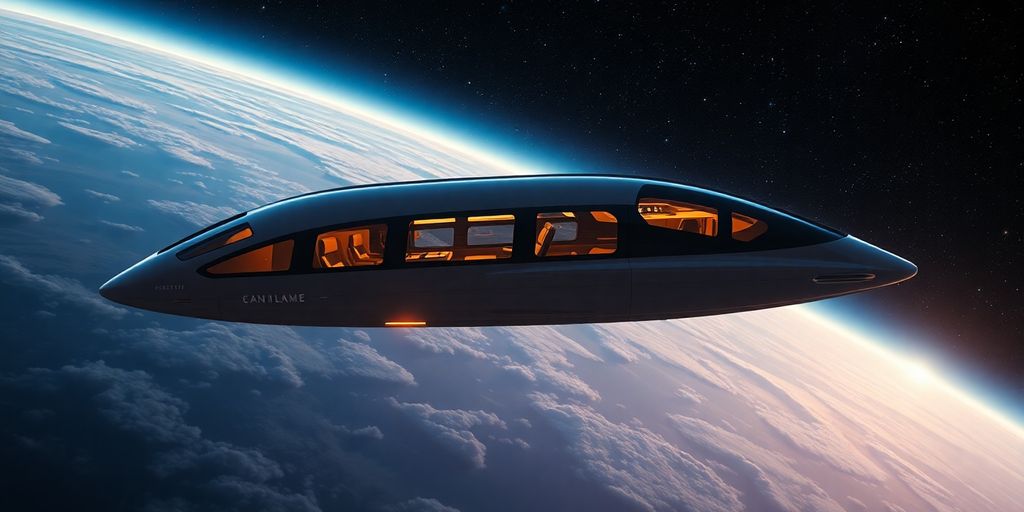Space travel is no longer just the stuff of science fiction; it’s becoming a real option for those who can afford it. With the rise of ultra-luxury space tourism, more companies are stepping up to offer unique adventures beyond our planet. From private spacecraft to lunar hotels, the future of space travel looks like an exclusive playground for the wealthy. This article dives into the exciting developments in ultra-luxury space tourism and what it means for adventure seekers.
Key Takeaways
- Ultra-luxury space tourism is gaining momentum with several private companies leading the charge.
- The Moon is emerging as a prime destination for space tourists, with plans for lunar hotels and unique experiences.
- Safety and innovative technology are top priorities for companies developing space travel options.
- Government partnerships with private firms are shaping the future of space tourism, making it more accessible.
- The market for space tourism is expected to grow significantly, attracting high-net-worth individuals and creating new business opportunities.
The Rise of Ultra-Luxury Space Tourism
Defining Ultra-Luxury Space Experiences
What exactly is ultra-luxury space tourism? It’s not just about going to space; it’s about experiencing it in unparalleled comfort and style. We’re talking bespoke itineraries, personalized training, and access to exclusive facilities. It’s about turning a spaceflight into an unforgettable, once-in-a-lifetime adventure. The price tag? Astronomical, of course. But for those who can afford it, it represents the ultimate status symbol. The demand for orbital flights is expected to increase significantly, signaling a shift from niche luxury to a serious market.
- Personalized concierge services from start to finish
- Gourmet meals prepared by world-renowned chefs
- Custom-designed spacesuits and in-flight amenities
Ultra-luxury space tourism is about more than just the destination; it’s about the journey. It’s about pushing the boundaries of what’s possible and experiencing the universe in a way that few others ever will.
Key Players in the Space Tourism Market
Several companies are vying for dominance in this emerging market. You’ve got the big names like SpaceX, Blue Origin, and Virgin Galactic, each with its own approach to space travel. SpaceX is planning to send at least five private missions per year to orbit, marking a major acceleration in the commercialization of space. Then there are smaller, more specialized companies offering unique experiences, like lunar flybys or stays on the International Space Station. It’s a competitive landscape, with each player trying to outdo the others in terms of innovation, luxury, and exclusivity. These companies are developing innovative spacecraft and packages that cater to this niche market, making space travel a symbol of status and luxury.
The Role of Private Companies in Space Travel
Private companies are driving innovation and accessibility in space travel. They’re developing new technologies, lowering costs, and creating opportunities for a wider range of people to experience space. This shift from government-led programs to private ventures is transforming the space industry, making it more dynamic and competitive. Private companies are not only making space travel a reality but also shaping its future. Their involvement could introduce new players into the market, increasing competition and potentially lowering prices. Those interested in space travel should pay attention to emerging projects from these regions. The rise of luxury space travel is attracting elite travelers, offering exclusive and personalized experiences in space.
Innovative Spacecraft and Technologies
Advancements in Spacecraft Design
Spacecraft design is rapidly evolving to accommodate the unique needs of space tourists. We’re seeing improvements in cabin comfort, panoramic viewing options, and even artificial gravity concepts being explored for future space hotels. These advancements aim to make space travel more accessible and enjoyable for a wider range of people. Reusable rockets, like those from SpaceX and Blue Origin, are also playing a big role in reducing costs and increasing the frequency of spaceflights. It’s not just about getting there; it’s about getting there comfortably and safely.
Safety Measures for Space Tourists
Safety is, understandably, a top priority in space tourism. Companies are implementing rigorous training programs for space tourists, covering everything from emergency procedures to adapting to the space environment. Spacecraft are equipped with advanced life support systems and redundant safety features. The collaboration with space agencies like NASA helps ensure that the highest safety standards are met. It’s a complex challenge, but one that’s being taken very seriously. emerging projects are worth keeping an eye on.
The Future of Spacecraft Propulsion
The future of space tourism hinges on developing more efficient and sustainable propulsion systems. While chemical rockets are currently the standard, there’s growing interest in alternative technologies like ion propulsion, nuclear propulsion, and even advanced concepts like warp drives (though that’s still firmly in the realm of science fiction). These technologies promise to significantly reduce travel times and costs, opening up new destinations and possibilities for space tourists. The Starship project could reduce costs significantly.
The development of new propulsion systems is not just about speed and efficiency; it’s also about reducing the environmental impact of space travel. The industry is actively exploring ways to minimize its carbon footprint and ensure that space tourism is sustainable in the long term.
Here are some key areas of focus:
- Reusable Rocket Technology: Reducing waste and cost.
- Advanced Materials: Creating lighter and stronger spacecraft.
- Alternative Fuels: Exploring greener options for propulsion.
Lunar Tourism: The Next Big Thing

Exploring the Moon as a Destination
Okay, so the Moon. It’s not just for astronauts anymore, right? We’re talking about regular people, maybe even you, potentially hopping on a rocket and checking out the lunar surface. It sounds like something out of a movie, but it’s getting closer to reality. The idea of lunar tourism is gaining serious traction, and it’s not hard to see why. Think about it: bragging rights for life.
- Witnessing Earth from the Moon.
- Exploring lunar craters.
- Potentially conducting simple scientific experiments.
It’s a whole new level of travel, and while it’s still in its early stages, the possibilities are pretty mind-blowing. The Artemis program is a big deal, and the collaboration with companies like SpaceX is changing the game. It’s not just governments doing this anymore; private companies are stepping up, which could make lunar travel more accessible in the future.
Lunar Hotels and Accommodations
Hotels on the Moon? Seriously? Yeah, that’s the direction things are heading. Hilton is even planning a Moonbase Resort! It sounds wild, but companies are looking at how to build structures on the Moon, maybe using 3D printing and lunar materials. Imagine waking up, looking out the window, and seeing Earth hanging in the black sky.
- Artificial gravity systems.
- Low-gravity sports facilities.
- Guided EVA excursions on the lunar surface.
Unique Experiences on the Lunar Surface
What would you even do on the Moon? Well, besides taking a ton of pictures, there’s the whole low-gravity thing. Imagine bouncing around, exploring craters, and seeing the far side of the Moon. Companies are talking about pressurized rovers for exploring, and maybe even setting up research stations. Space Adventures is even offering lunar orbit experiences. It’s not just about seeing the Moon; it’s about experiencing it in a completely new way.
- Exploring lunar caves.
- Participating in lunar research.
- Viewing the Earthrise.
The Role of Government in Space Tourism

Public-Private Partnerships
Governments are increasingly teaming up with private companies to make space tourism a reality. These partnerships can take many forms, from sharing resources and expertise to jointly funding space missions. This collaboration is often essential because space projects are incredibly expensive and complex. It’s not just about money, though. Governments bring regulatory experience and a long-term vision, while private companies bring innovation and agility. This mix can really speed things up and make space travel more accessible. For example, NASA is working with SpaceX on lunar missions, combining NASA’s deep space knowledge with SpaceX’s rocketry skills.
Regulatory Frameworks for Space Travel
As space tourism takes off, governments need to create rules to keep everyone safe and ensure fair play. Regulations cover everything from spacecraft design and operation to passenger training and environmental impact. It’s a tricky balance. Too much regulation could stifle innovation, but too little could lead to accidents or irresponsible behavior. By 2028, government regulations for commercial spaceflight are expected to tighten. The goal is to create a stable and trustworthy space tourism industry that benefits everyone. These frameworks also address liability issues – who is responsible if something goes wrong during a spaceflight?
Funding and Support for Space Initiatives
Governments play a big role in funding space exploration and development. This can include direct investment in space agencies, tax breaks for space companies, and grants for research and development. This developing market is projected to be worth $5 billion by 2035. Countries like Japan and the UAE are investing in space tourism projects, with billions in funding planned. This support helps to drive innovation, create jobs, and inspire the next generation of scientists and engineers. It also helps to ensure that space exploration benefits all of humanity, not just a few wealthy individuals.
Government support is vital for the growth of space tourism. It provides the necessary resources, regulatory framework, and long-term vision to make space travel safe, sustainable, and accessible to a wider range of people. Without government involvement, space tourism would likely remain a niche activity for the ultra-rich.
Here’s a quick look at some key areas of government funding:
- Research and Development: Supporting new technologies and innovations.
- Infrastructure: Building and maintaining launch facilities and spaceports.
- Education: Training the next generation of space professionals.
The Experience of Space Travel

Training for Space Tourists
So, you’ve booked your ticket to space? Awesome! But before you blast off, there’s some training involved. It’s not just about strapping in and hoping for the best. Think of it as astronaut boot camp, but with slightly better snacks. You’ll learn about the effects of G-forces, how to handle zero gravity, and emergency procedures. It’s all designed to make sure you’re prepared for anything space throws at you. The training programs are tailored to the specific mission, whether it’s a suborbital hop or a trip to a space station stay.
What to Expect During a Space Flight
Okay, launch day is here! The anticipation is probably through the roof. During the flight, expect a wild ride. The initial acceleration can be intense, pushing you back into your seat. Once you reach space, though, it’s a whole different ballgame. Zero gravity is the star of the show. Floating around, doing somersaults, and watching the Earth from above is an experience unlike any other. You might experience some motion sickness initially, but most people adjust quickly. And don’t forget the views! Seeing our planet from space is supposed to be life-changing. Companies like Zero-G use modified Boeing 727s to simulate zero gravity on parabolic flights.
Post-Flight Experiences and Souvenirs
So, you’re back on Earth. What now? Well, expect to feel a little disoriented at first. Re-adjusting to gravity takes a bit of time. Many space tourism companies offer post-flight medical check-ups and debriefing sessions to help you process the experience. And of course, there are souvenirs! From signed mission patches to photos and videos of your space adventure, you’ll have plenty of ways to remember your trip. The memories, though, are what you’ll really treasure.
Coming back to Earth after experiencing space is often described as a profound and transformative event. Many space travelers report a renewed appreciation for our planet and a sense of connection to humanity as a whole. It’s an experience that stays with you long after you’ve touched down.
Here’s a quick look at what you might expect:
- Medical check-up
- Debriefing session
- Souvenir package
Market Trends in Space Tourism
Growth Projections for Space Travel
The space tourism market is really taking off! It’s not just a sci-fi dream anymore. The industry is predicted to grow at a CAGR of 15-20% from 2025 to 2030. That’s a huge jump, driven by more people wanting to go, better tech, and prices slowly coming down. By 2030, the whole market could be worth $10-15 billion. Keep an eye on emerging companies and new tech if you’re thinking about investing. There are also opportunities in things like space travel insurance and astronaut training.
Target Demographics for Space Tourism
Right now, space travel is mostly for the super-rich. But as things get cheaper, it’ll open up to a wider group of wealthy people. Over 20,000 people have already signed up for suborbital flights as of 2024! It’s not just curiosity; it’s a desire for adventure and to be part of something big. Companies that get involved early can connect with this excitement and attract high-value customers. By 2030, we could see over 1,000 people traveling to space each year. This shift means space travel will move from being super exclusive to a luxury adventure for more people. Businesses should get ready for a future where space travel is more common. SpaceX plans to send at least five private missions per year to orbit by 2027.
Emerging Markets in Space Exploration
Japan and the UAE are putting a lot of money into space tourism projects. Their investments could bring new players into the market, which could mean more competition and maybe lower prices. Also, artificial gravity concepts for space hotels could be tested by 2029-2030. The demand for orbital flights is expected to increase by 200-300% from 2025 to 2030. This surge signals a transformative moment for the commercial space industry.
As orbital stays become more affordable, space tourism will no longer be a rare spectacle but a recurring commercial industry with long-term growth potential. Companies that align early with this trend—whether through partnerships, sponsorships, or technological innovations—will gain first-mover advantages in an industry poised for exponential expansion.
Challenges Facing Space Tourism
Technical and Logistical Hurdles
Space tourism, while exciting, faces significant technical and logistical challenges. Getting people safely into space and back isn’t easy, and reliability is key. We’re not quite at the point where space travel is as routine as air travel, and that presents some real problems. Think about it: every launch is a complex operation with a lot of things that could go wrong. Plus, the infrastructure needed to support regular space tourism is still under development. We need more launch sites, better spacecraft, and more efficient ways to manage all the logistics. It’s a bit like building an airport while the planes are already taking off.
The complexity of space missions requires constant innovation and rigorous testing. Overcoming these technical hurdles is essential for the long-term viability of space tourism.
Safety Concerns for Tourists
Safety is a huge concern, and it’s not just about the launch itself. Space is a harsh environment. Cosmic radiation is a big deal, and we need better ways to protect tourists from its harmful effects. Then there’s the whole issue of zero gravity, which can cause health problems for some people. Training for space tourists bespoke space travel itineraries needs to be thorough, but it also needs to be accessible to people who aren’t professional astronauts. We also need to think about emergency situations. What happens if something goes wrong during a flight? How do we rescue people from space? These are tough questions that need solid answers before space tourism can really take off.
Environmental Impact of Space Travel
We can’t ignore the environmental impact of space travel. Rocket launches produce a lot of pollution, and they can damage the ozone layer. Plus, there’s the issue of space debris. As we launch more and more satellites and spacecraft, the amount of junk in orbit increases, and that creates a hazard for future missions. We need to find ways to make space travel more sustainable, and that means developing cleaner fuels, reducing pollution, and managing space debris responsibly. It’s about making sure that our quest to explore the cosmos doesn’t end up harming our own planet. Countries like Japan and the UAE are investing in emerging projects to help with this.
Here’s a quick look at some of the environmental concerns:
- Air pollution from rocket launches
- Ozone layer depletion
- Space debris accumulation
- Carbon footprint of space tourism
Cultural Impact of Space Tourism

Space Tourism in Popular Media
Space tourism is starting to pop up everywhere – in movies, TV shows, and even video games. It’s not just about astronauts anymore; now, it’s about regular people (with a lot of money) going to space. This increased visibility is changing how we think about space travel. It’s becoming less of a distant dream and more of a potential reality, at least for some. You see it influencing storylines and character arcs, making space seem less like science fiction and more like a high-end travel destination. It’s interesting to see how media portrays the experience, often focusing on the luxury and adventure aspects. This can shape public perception and fuel interest in emerging projects.
Influence on Art and Creativity
Space has always been a muse for artists, but space tourism is adding a new layer. Imagine the art that will come out of actually experiencing space – the colors, the weightlessness, the view of Earth. It’s bound to inspire some incredible creations. We might see new forms of art that can only exist in zero gravity, or music composed with the sounds of space. The possibilities are endless. Space tourism could be a catalyst for a whole new wave of artistic expression, pushing boundaries and challenging our perceptions of what art can be. It’s not just about painting stars; it’s about capturing the feeling of being among them. This could lead to a surge in demand for orbital flights.
The New Space Race and Its Implications
We’re not just talking about governments anymore; private companies are now major players. This new space race is driven by innovation and competition, which is pushing the boundaries of what’s possible. It’s not just about getting to the moon first; it’s about developing new technologies, creating new markets, and inspiring the next generation of scientists and engineers. This competition can lead to faster progress and lower costs, making space travel more accessible in the long run. But it also raises questions about regulation, safety, and the ethical implications of commercializing space. It’s a complex landscape with a lot of potential, but also a lot of challenges. Over 20,000 people have signed up for suborbital flights, which is a powerful indicator that commercial space tourism is no longer a niche market.
The rise of private space companies is changing the game. It’s not just about scientific exploration anymore; it’s about business, innovation, and the pursuit of new frontiers. This shift has huge implications for how we think about space and our place in the universe.
Future of Ultra-Luxury Space Tourism
Predictions for the Next Decade
The next ten years look wild for space tourism. We’re not just talking about quick hops to the edge of space anymore. The industry is gearing up for orbital stays and even lunar visits. Think about it: space hotels could be a real thing by 2030. Companies are already working on space habitats, and that’s a huge step. Plus, with companies like SpaceX planning more frequent missions, space travel will become less of a once-in-a-lifetime thing and more of a regular luxury. Japan and the UAE are investing big bucks, too, which means more competition and maybe even lower prices down the road. It’s going to be interesting to watch.
Potential Destinations Beyond the Moon
Okay, the Moon is cool, but what’s next? Mars is the obvious answer, but it’s a long way off. In the meantime, there’s talk of asteroid mining tours or even building habitats in orbit around other planets. The possibilities are pretty much endless. Imagine private spaceflights to see the rings of Saturn up close or visiting a space station orbiting Jupiter. It sounds like science fiction, but who knows? Maybe in 50 years, it’ll be the new normal. For now, companies are focused on making lunar tourism a reality, but the long-term vision is definitely out there.
The Evolution of Space Travel Experiences
Space tourism isn’t just about getting to space; it’s about the whole experience. Right now, it’s pretty basic: a few minutes of weightlessness and a view of Earth. But that’s going to change. We’re talking about custom-made spacesuits, zero-gravity experiences, and even space food. And as more people go to space, there will be a need for all sorts of new services. Think about it: space hotels with artificial gravity, lunar rovers for exploring the Moon, and even ultra-rich space tourism with virtual reality experiences that let you explore other planets from your hotel room. The future of space travel is all about making it more comfortable, more exciting, and more accessible (at least for those who can afford it). By 2030, over 1,000 people could be traveling to space annually, so get ready for a whole new world of travel experiences.
The shift from rare spectacle to recurring commercial industry is a big deal. Companies that get in early will have a huge advantage. Think partnerships, sponsorships, and new tech. It’s all about getting ahead of the curve.
Here’s a quick look at how things might change:
- More frequent flights
- More diverse destinations
- More personalized experiences
As we look ahead, ultra-luxury space tourism is set to become a thrilling reality. Imagine floating in zero gravity while enjoying breathtaking views of Earth from above! This new adventure will not only offer unique experiences but also redefine what it means to travel in style. If you’re curious about how to be part of this exciting journey, visit our website for more information on luxury travel options that are out of this world!
The Future of Luxury in Space Awaits
So, is space travel the next big thing in luxury adventures? It sure looks that way. With companies like SpaceX and Blue Origin making strides, the idea of hopping on a spacecraft for a trip around the Moon is becoming less of a fantasy and more of a reality. Sure, it’s still pricey, but as technology improves and more players enter the game, we might see prices drop. Imagine a future where you can book a stay at a lunar hotel or take a quick flight to see Earth from above. It’s wild to think about, but the groundwork is being laid right now. For those who can afford it, space tourism could soon be the ultimate getaway. Keep your eyes on the stars; the adventure is just beginning.
Frequently Asked Questions
What is ultra-luxury space tourism?
Ultra-luxury space tourism is a high-end travel experience where wealthy individuals can travel to space, often with custom services and exclusive amenities.
Who are the main companies involved in space tourism?
Key players in space tourism include SpaceX, Blue Origin, and Virgin Galactic, among others, which are all working to make space travel available to private citizens.
How safe is space travel for tourists?
Safety is a top priority for space tourism companies. They implement strict safety measures and training for tourists to ensure a secure experience.
What can tourists expect during a space flight?
Tourists can expect a unique experience, including weightlessness, stunning views of Earth and space, and possibly even time spent in lunar orbit.
What are some future destinations for space tourism?
In addition to the Moon, future destinations may include Mars and space hotels, where tourists can enjoy unique experiences in low gravity.
How much does it cost to travel to space?
Prices for space tourism vary widely, with some experiences costing tens of millions of dollars, while others may be more affordable as the industry grows.
What kind of training do space tourists need?
Space tourists usually undergo several months of training, which includes learning about the spacecraft, safety procedures, and experiencing simulations of space conditions.
What are the environmental impacts of space tourism?
Space tourism can have environmental impacts, such as emissions from rocket launches. Companies are working on ways to reduce these effects as the industry develops.












